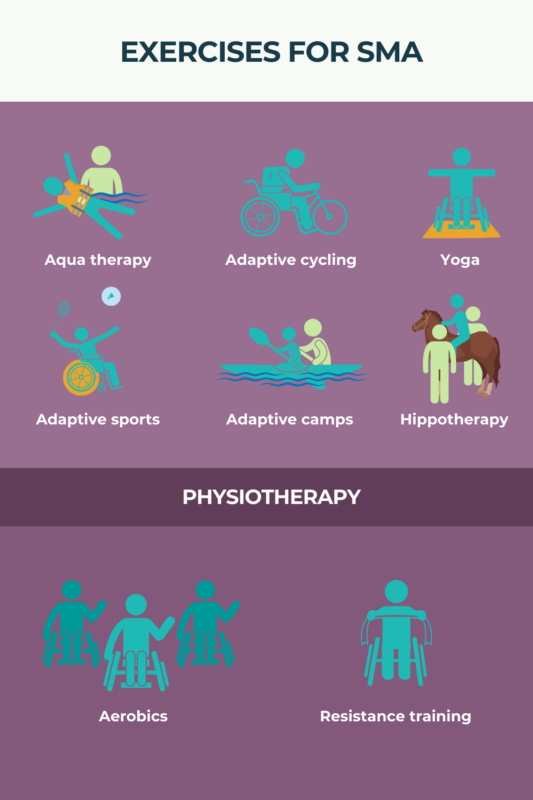Exercise and physical therapy for SMA
Written by Susie Strachan | Fact-checked by Patricia Silva, PhD | Updated Jan. 10, 2025

Exercise can enhance the lives of people with spinal muscular atrophy (SMA) by improving or maintaining function and quality of life. This is accomplished through activities that help to maintain or increase muscle strength, cardiovascular endurance, and joint flexibility.
Before beginning to exercise, it’s important to speak with a physical or occupational therapist to establish a safe and appropriate exercise program.
A physical or occupational therapist should perform a thorough evaluation of the individual to identify their specific physical limitations, personal goals, preferences, and precautions.
An exercise program can then be tailored to the individual’s unique needs. Stretching or flexibility exercises will improve or maintain joint range of motion. This is very important for efficient mobility and prevention of joint contractures (a limitation in the range of motion of a joint). Aerobic or cardiovascular exercise is important to build or maintain lung capacity, respiratory strength, and heart function. Resistance or strength training is necessary to build or maintain muscle strength.
Once an appropriate baseline exercise program is developed, then other activities can be added such as therapeutic games for children, aqua therapy, or the use of an adaptive bike or other adapted sporting equipment.
It is important not to overexercise, as muscle damage caused by exercise can increase muscle weakness and atrophy (wasting or thinning of muscle mass). Muscles in people with SMA may not heal from injury easily and people may become fatigued, both physically and mentally.
 Find an SMA specialist near you
Find an SMA specialist near you
Benefits of exercise for people with SMA
SMA is a genetic disease characterized by the loss of motor neurons, or nerve cells controlling the movement of voluntary muscles, that leads to muscle weakness or atrophy. SMA is divided into five main types — 0, 1, 2, 3, and 4, which are caused by mutations in the SMN1 gene.
Activities dependent on muscles — such as walking, sitting, standing, eating, and breathing — can be affected.
Treatment such as exercise and physiotherapy are therefore important in reducing the symptoms of SMA. The disease can cause muscle weakness in arms and legs, which affects mobility and function. SMA can also affect postural muscles. These muscles in and around the pelvis, back, abdomen, and neck support the body when sitting and standing. Weak postural muscle can contribute to problems with sitting and standing balance.
The benefits of exercise for people with SMA include strengthened muscles, improved flexibility, improved motor function, prevented contractures, improved posture, and better mental health.
Physical therapy assistant Emily Jones said healthcare professionals such as physiotherapists need to be proactive regarding their SMA patients.
“Being evaluated by a physical therapist is the best way to start. With SMA really varying from person to person, you need your strength tested and to have your function evaluated,” she said, adding the goal of guided exercise is to increase core control, sitting balance and overall functional levels.
Physiotherapy exercises depend on the level of severity each person has. But it also depends on the age of the person. Children with SMA enjoy playing games as they work through the exercises, while adults can focus more on the reason and goals for each exercise.
For children, make exercise a game. Specialized equipment, like bikes, modified swings, and toys, also will make exercise more enjoyable for kids. Adaptive aids and braces can be used to support children during exercise activities.
"Many of us with SMA were told never to exercise, because any physical exertion of our muscles would or could exacerbate our muscle weakness," said Michael Morale, who has SMA. "Now that many of us are on Spinraza or Evrysdi, ... many of our doctors have agreed that physical therapy could show some crucial benefits. I go to physical therapy once a week, and I make this part of my weekly routine to ensure that I'm doing everything that I can to benefit my body and mind.
"Physical therapy to me is just as much mental as it is physical, and after working out with my physical therapist, I not only feel better from a physical standpoint, I'm also much stronger mentally because I know that I've done something good for my body. Sometimes my schedule or the schedule of my physical therapist will mean that we may have to skip a week every once in a while, but I consider this just a challenge that life throws our way."
Helpful exercises for people with SMA
Beyond physiotherapy exercises done in a clinical setting, many people with SMA enjoy activities such as swimming, biking, and stretching with yoga.
Jones said to choose enjoyable exercises that go beyond the weightlifting and upright functional training done in a clinical setting.
“Anything that increases your function. Have goals in mind on what you would like to improve on (realistically) and then exercises can come from there,” she said, adding that when exercising with a child, their attention span and goals will be different. Therefore, exercises will differ as well.
While it can be extremely difficult for a person who has SMA to do the more physical exercises on land, water therapy offers the chance to move their arms and legs, and enjoy the feeling of floating, with the assistance of a therapist. Swimming and/or water exercise can maintain or improve muscle strength, flexibility, and cardiovascular endurance.
Remember to keep safety first:
- Keep assistive equipment, like a suction machine, at the poolside.
- Plan how to get in and out of the water. A pool that has assistive equipment, such as a Hoyer lift, can be a good option.
- Choose a pool with the right temperature. Ninety to 95 degrees Fahrenheit is optimal, but more vigorous exercises can be done in a pool maintained at 86-88 F.
- If required, wear a personal flotation device or a neck support, and use pool noodles and other devices to help with stability in the water.
“Since starting aqua therapy in 2015, it’s become a key part of my physical, mental, and emotional well-being," said Kevin Schaefer, who has SMA. "I love the movement and relaxation that comes with being in the water. My physical therapists know my needs and capabilities, and they support me during every appointment. I have limited physical strength and I’m not concerned with ‘getting stronger,’ so much as I am having a good quality of life. Aqua therapy gives me freedoms to exercise and move that I don’t have on land.”
Biking also improves muscle strength and posture, improves balance and builds cardiovascular capacity. It’s a social activity that can be done with friends and family. Some adaptive bikes can be pedaled by hand, while tandem bicycles allow an adult to pedal while the person with SMA rides in front, behind, or beside. Bikes also can be outfitted with electric motors to assist the rider.
At its heart, yoga is a spiritual practice intended to provide harmony between the body and mind. For those living with SMA, seated yoga can help strengthen muscles, improve balance, and can provide a better outlook on life through breath work and meditation. Look for videos on YouTube that lead people through SMA-specific yoga moves, join an online adaptive yoga class, or seek out in-person adaptive yoga classes. Physiotherapists also can demonstrate and guide you through moves intended to stretch and strengthen atrophied muscles.

Exercising safely
People with SMA should work with a physical or occupational therapist to establish a safe exercise program to ensure maximum function and improved quality of life. For some people, orthotic braces or other adaptive aids may be necessary for SMA support during exercise or daily activities.
Falls are a serious concern for many people with SMA, as they can cause injuries and pain resulting in loss of mobility and function. Research suggests muscle weakness and fatigue increase the risk for falls. People with SMA may not be able to control their muscle strength but most people can find ways to manage fatigue to reduce their risk for falls. While it’s not always possible to avoid fatigue, energy conservation strategies, such as activity management or the use of assistive or power mobility devices, can help to reduce fatigue.
“Make sure you have a professional with you or advising you on your exercises to improve safety,” Jones said.
Situations that have the potential to cause falls include:
- transfers, such as from a wheelchair to physiotherapy or aqua therapy equipment
- standing and walking, especially around items that can cause a trip and fall
- low-light conditions.
Exercise tips
- Build exercise into the daily schedule. Exercise on the same day of the week or at the same time of day.
- Exercise with a friend.
- Do enjoyable exercises. Explore swimming, hippotherapy, adaptive biking, and wheelchair sports.
- Don’t worry about perfection. Missing an exercise day happens.
- Break exercise routines into shorter sets.
- For children, seek out adaptive summer camps and adaptive sports organizations.
Physical therapy for people with SMA
A physical or occupational therapy expert will introduce specialized exercises that can help reach functional goals. They also ensure increased safety when working with transfers and balancing activities.
A comprehensive exercise program could include:
- gentle stretching for specific areas identified by a therapist
- core strengthening with or without resistance bands
- active movement of the trunk, neck, arms, and legs in all directions as possible
- resistance or strength training for trunk, arms, and legs only (upon the recommendation of a therapist)
- sitting balance and stability exercises.
Physical therapy and regular exercise is just one component of living with SMA that, when combined with disease-modifying treatments and other supportive therapies, can help to enhance the quality of life of people with SMA.
SMA News Today is strictly a news and information website about the disease. It does not provide medical advice, diagnosis, or treatment. This content is not intended to be a substitute for professional medical advice, diagnosis, or treatment. Always seek the advice of your physician or other qualified health provider with any questions you may have regarding a medical condition. Never disregard professional medical advice or delay in seeking it because of something you have read on this website.
FAQs about exercise and physical therapy for SMA
Yes, people with spinal muscular atrophy (SMA) can exercise safely. A conversation with a healthcare provider should be done about where to start, and how to perform each exercise safely. Be aware that overdoing exercise and fatigue can cause mishaps such as falls, and to take it slow in the beginning.
Those which maintain and improve strength, balance, and range of motion. Along with physiotherapy, choose enjoyable exercises. These can range from gentle chair yoga stretches to aqua therapy, adaptive biking, hippotherapy, and more vigorous wheelchair sports. A healthcare provider can speak about exercises and activities tailored to the person with spinal muscular atrophy.
Yes, they can. Some activities for children with spinal muscular disorders can include aqua therapy and swimming, wheelchair-adapted sports, along with horseback riding (hippotherapy).
Related Articles











